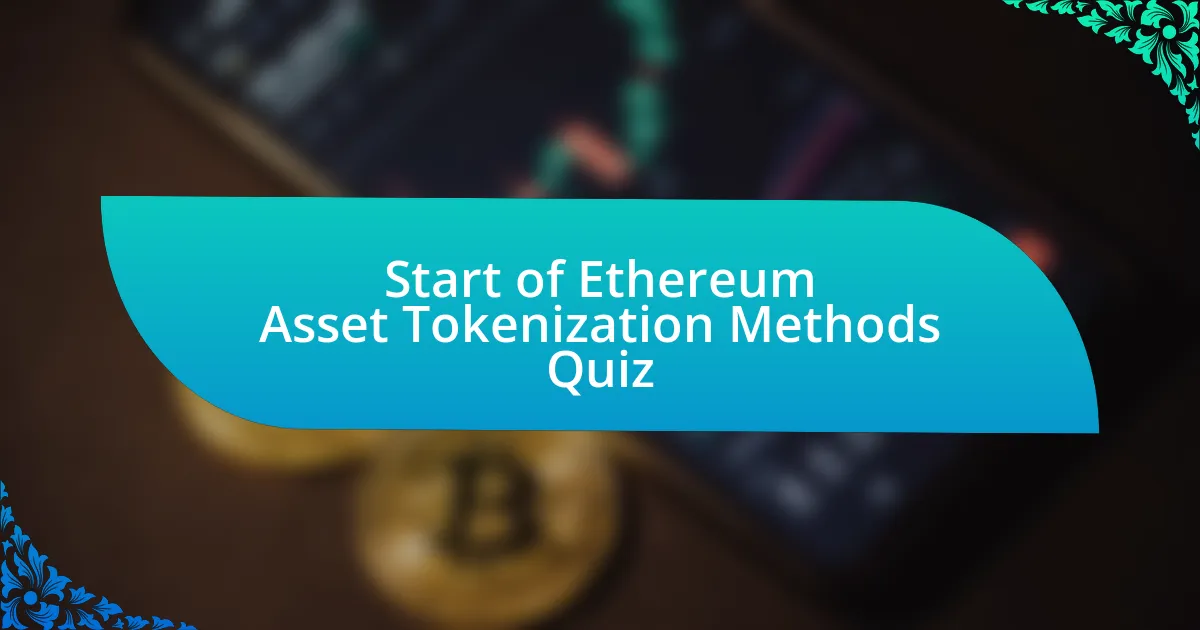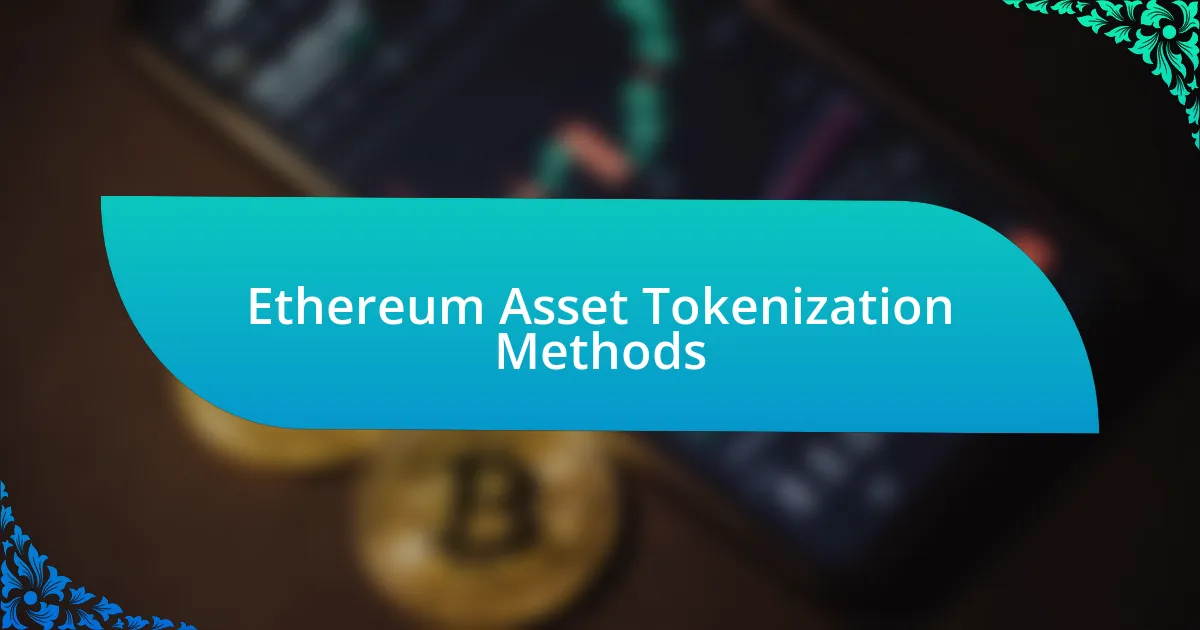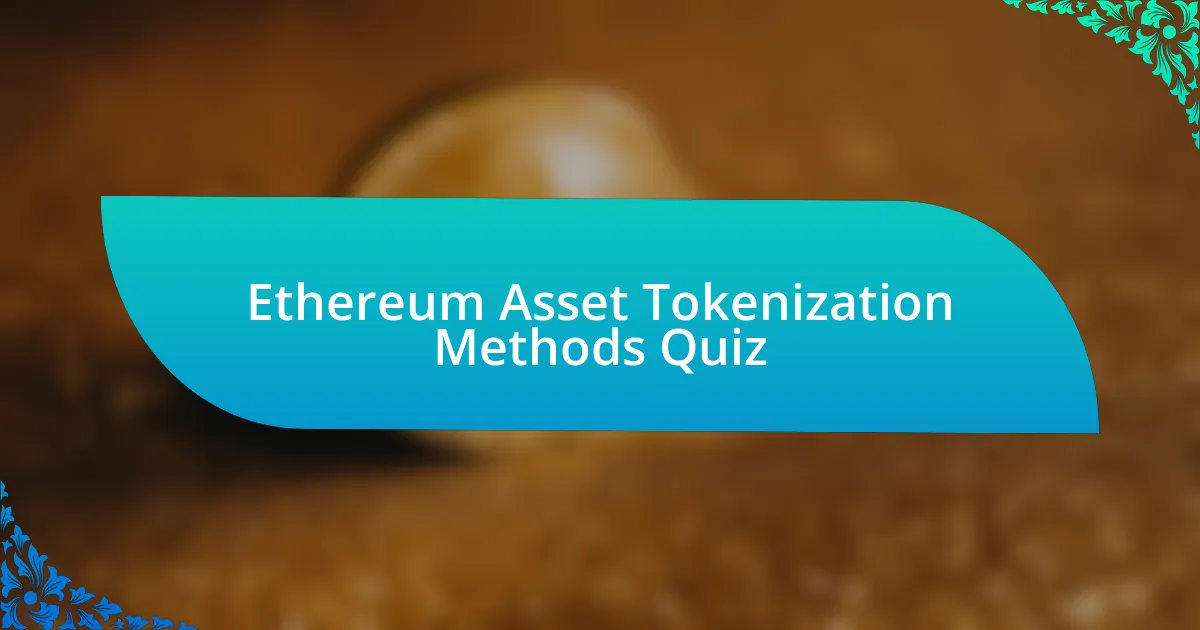
Start of Ethereum Asset Tokenization Methods Quiz
1. What is asset tokenization?
- Asset tokenization involves the creation of physical copies of digital assets.
- Asset tokenization is the method of converting financial statements into digital formats.
- Asset tokenization refers to the practice of encrypting digital files for security.
- Asset tokenization is the process of creating digital tokens that represent ownership or rights to physical or intangible assets.
2. What are the steps to tokenize an asset?
- The steps consist of gathering community feedback, hosting a series of meetings, enrolling in a certification program, and merging with a competitor.
- The steps include selecting an asset to tokenize, defining the tokenomics model, choosing a blockchain platform, developing smart contracts, and establishing the framework for trading the tokens.
- The process includes creating a business plan, choosing a physical location, hiring staff, and implementing a traditional banking system.
- The steps involve identifying stakeholders, establishing a legal framework, creating a marketing strategy, and launching a public offering.
3. What is tokenomics?
- Tokenomics is primarily about blockchain coding and software development.
- Tokenomics refers only to the marketing strategies for selling tokens.
- Tokenomics is the process of creating new cryptocurrencies and mining them.
- Tokenomics is the study of the economics of tokens, including their supply and demand characteristics, token value, and the rights associated with them.
4. Which blockchain platforms are commonly used for asset tokenization?
- Litecoin
- Ripple
- Bitcoin
- Ethereum
5. What is the role of smart contracts in asset tokenization?
- Smart contracts create and manage legal agreements outside the blockchain framework.
- Smart contracts automate the execution of pre-programmed rules related to the issuance and trading of tokenized assets.
- Smart contracts act as intermediaries managing negotiations between asset buyers and sellers.
- Smart contracts serve as physical documentation for asset ownership and rights.
6. How does asset tokenization enable peer-to-peer trading?
- Asset tokenization restricts trading to a centralized exchange platform only.
- Asset tokenization requires intermediaries to facilitate trading between buyers and sellers.
- Asset tokenization eliminates ownership rights for investors in peer-to-peer transactions.
- Asset tokenization enables peer-to-peer trading by allowing the direct transfer of ownership between asset owners and investors without the involvement of third-party intermediaries.
7. What is end-to-end asset traceability in tokenization?
- End-to-end asset traceability involves tracing the entire history of activities performed over tokenized assets in a distributed ledger, verifying asset origin and provenance, and preventing fraud and counterfeiting.
- End-to-end asset traceability is solely about tracking the geographical location of assets during shipping and handling.
- End-to-end asset traceability refers to the process of adding physical items to a digital inventory in a centralized database.
- End-to-end asset traceability means ensuring that all assets comply with pre-defined legal regulations without tracking their history.
8. What is automated recordkeeping in tokenization?
- Automated recordkeeping necessitates physical documents to maintain proof of all token transactions.
- Automated tracking uses manual logs to document token transactions for review and auditing.
- Automated recordkeeping involves all transactions on tokenized assets being automatically validated, timestamped, cryptographically encrypted, and recorded in an immutable ledger available to asset owners and investors.
- Automated recordkeeping relies on third-party services to verify and store transaction records of token assets.
9. What are tokenized assets?
- Tokenized assets are digital currencies created for online purchases.
- Tokenized assets are physical items traded on traditional markets.
- Tokenized assets are government-issued securities in paper form.
- Tokenized assets are blockchain-based tradeable tokens backed by underlying tangible and intangible assets.
10. What are the different types of tokens that can be issued in asset tokenization?
- Access tokens, loyalty program tokens, promotional tokens, and dividend tokens can be issued in asset tokenization.
- Loyalty tokens, promotional tokens, transaction tokens, and gift tokens can be issued in asset tokenization.
- Digital currency tokens, collectible tokens, bridge tokens, and credit tokens can be issued in asset tokenization.
- Utility tokens, security tokens, governance tokens, and NFTs can be issued in asset tokenization.
11. How do compliance requirements impact asset tokenization?
- Compliance requirements eliminate the need for thorough recordkeeping in asset tokenization.
- Compliance requirements involve analyzing global, country-, and industry-specific legal regulations relevant for the asset, such as SEC regulations for financial securities and HIPAA for healthcare assets.
- Compliance requirements simplify the process by allowing free trade of all digital assets without regulations.
- Compliance requirements ensure all tokenized assets are automatically exempt from legal scrutiny and taxes.
12. What is the significance of custodianship in asset tokenization?
- Custodianship allows users to create tokens without real underlying assets.
- Custodianship is only relevant for non-physical assets and has no impact on real assets.
- Custodianship prevents any verification of asset ownership in transactions.
- Custodianship ensures that tokenized assets are constantly backed by the underlying real assets, maintaining the integrity of the tokenized assets.
13. How do native tokens differ from tokenized assets?
- Native tokens represent physical assets and are traded in traditional markets.
- Tokenized assets are only used for digital goods and cannot represent physical assets.
- Tokenized assets derive their value solely from market speculation, unlike native tokens.
- Native tokens are built directly on-chain and derive their value from their existence on the blockchain, whereas tokenized assets represent pre-existing real assets and exist both on and off the chain.
14. What is the role of oracles in Ethereum?
- Oracles serve as validators for all transactions on the Ethereum blockchain.
- Oracles create new tokens to improve scalability on the Ethereum network.
- Oracles manage user accounts in Ethereum, ensuring data privacy and protection.
- Oracles provide external data to smart contracts on the Ethereum network, enabling them to make decisions based on real-world information.
15. What is the Ethereum Virtual Machine (EVM)?
- The EVM is a framework for developing mobile applications on the Ethereum network.
- The EVM is a centralized database for storing transactions securely.
- The EVM is a type of mining software used to mine Bitcoin and Ethereum.
- The EVM is a decentralized virtual machine capable of handling scripts using the public nodes network, and it is Turing complete.
16. What is the value token for Ethereum?
- Litecoin (LTC)
- Bitcoin (BTC)
- Ether (ETH)
- Ripple (XRP)
17. What is Ether used for in the Ethereum network?
- Ether measures transaction fees for Bitcoin transfers and is used solely for trading.
- Ether is a type of physical currency that can be used to buy goods in stores.
- Ether powers the Ethereum network by providing the nodes an incentive to validate the blockchain blocks and powering smart contracts.
- Ether is a database management tool used for organizing smart contracts on the Ethereum platform.
18. What is the consensus algorithm used by Ethereum?
- Ethereum uses a delegated proof-of-stake consensus algorithm.
- Ethereum uses a Byzantine fault tolerance consensus algorithm.
- Ethereum uses a proof-of-work consensus algorithm.
- Ethereum uses a proof-of-stake consensus algorithm.
19. How do smart contracts enforce actions related to tokenized assets?
- Smart contracts automatically enforce fixed actions related to tokenized assets upon particular events pre-defined by token issuers.
- Smart contracts require human intervention to execute actions related to tokenized assets at all times.
- Smart contracts only store data about tokenized assets and do not enforce any actions.
- Smart contracts execute dummy transactions without relating to tokenized assets.
20. What is MetaMask?
- MetaMask is a hardware wallet for storing Bitcoin securely offline.
- MetaMask is a social media platform for cryptocurrency discussions.
- MetaMask is a popular browser-based Ethereum wallet used to interact with decentralized applications (dApps) on the Ethereum network.
- MetaMask is a trading exchange for buying and selling cryptocurrencies.
21. What is Truffle?
- Truffle is a programming language used for web development.
- Truffle is a cocktail made primarily of chocolate liqueur and cream.
- Truffle is a type of expensive mushroom used in gourmet cooking.
- Truffle is a development environment for Ethereum that includes tools for creating, testing, and deploying smart contracts and decentralized applications.
22. What is the block time and average block size in Ethereum?
- The block time is approximately 14 seconds, and the average block size is around 2 KB.
- The block time is approximately 30 seconds, and the average block size is around 1 MB.
- The block time is approximately 10 seconds, and the average block size is around 500 KB.
- The block time is approximately 20 seconds, and the average block size is around 250 KB.
23. Can transactions be kept hidden on the Ethereum network?
- Yes, Ethereum has a built-in option for anonymous transactions.
- Yes, transactions can be kept hidden using private keys.
- No, all transactions on the Ethereum network are public.
- No, transactions are only visible to network administrators.
24. Is the user’s private key used to sign transactions?
- No, the private key is only for storing tokens.
- No, the user`s private key is never used for transactions.
- Yes, transactions are signed using a public key instead.
- Yes, the user’s private key is used to sign transactions on the Ethereum network.
25. What measures the amount of computational effort required to execute specific operations on the Ethereum network?
- Token
- Block
- Ether
- Gas
26. What are the use cases for smart contracts in real estate?
- Smart contracts manage physical property maintenance and repairs directly.
- Smart contracts can be used in real estate to automate the transfer of property ownership once payment is received.
- Smart contracts are exclusively for financial derivatives and not real estate transactions.
- Smart contracts replace all human interactions in real estate dealings.
27. What is the difference between utility tokens, security tokens, and governance tokens?
- Utility tokens are always non-transferable, security tokens are used for voting, and governance tokens have fixed values.
- Utility tokens represent company shares, security tokens are for discounts, and governance tokens are only for trading assets.
- Utility tokens are used for a specific purpose, security tokens represent ownership or rights to an asset, and governance tokens give holders voting rights.
- Utility tokens are exclusively for payments, security tokens are issued only by governments, and governance tokens have no real function.
28. How does Stellar differ from Ethereum in terms of transaction processing speed and cost?
- Stellar enables fast transaction processing and charges significantly lower costs per transaction compared to Ethereum.
- Ethereum offers faster transaction speeds at higher costs per transaction than Stellar.
- Stellar has slower transaction speeds but lower costs per transaction than Ethereum.
- Ethereum processes transactions slower but charges less than Stellar does.
29. What is the Federated Byzantine Agreement (FBA) consensus protocol used by Stellar?
- The FBA consensus protocol ensures safe and fault-tolerant transactions.
- The FBA consensus protocol designs graphical user interfaces.
- The FBA consensus protocol is used for high-speed internet connectivity.
- The FBA consensus protocol manages database storage.
30. How do tokenized assets meet AML/KYC requirements?
- Tokenized assets only meet AML/KYC requirements through external audits.
- Tokenized assets eliminate all compliance measures entirely.
- Tokenized assets on Stellar meet AML/KYC requirements through the proprietary compliance protocol employed by the platform.
- Tokenized assets do not require any identification for transactions.

Quiz Completion: Well Done!
Congratulations on completing the quiz on Ethereum Asset Tokenization Methods! This process has not only tested your knowledge but also enhanced your understanding of this innovative topic. You may have learned about the different token standards, such as ERC-20 and ERC-721, and how they transform traditional assets into digital ones on the Ethereum blockchain.
As you navigated through the questions, you likely discovered key concepts regarding the advantages of asset tokenization. These include increased liquidity, fractional ownership, and simplified transactions. Understanding these methods is essential for anyone interested in the future of finance and the role of blockchain technology.
We invite you to dive deeper into the subject by exploring the next section on this page. There, you will find detailed information about Ethereum Asset Tokenization Methods that can further expand your knowledge. Take this opportunity to enhance your insights and stay ahead in this rapidly evolving field!

Ethereum Asset Tokenization Methods
Overview of Ethereum and Asset Tokenization
Ethereum is a decentralized blockchain platform that enables developers to build and deploy smart contracts and decentralized applications (dApps). Asset tokenization refers to the process of converting real-world assets into digital tokens on a blockchain. In the Ethereum ecosystem, tokenization allows for increased liquidity, fractional ownership, and more efficient market transactions. This method leverages Ethereum’s standards, such as ERC-20 and ERC-721, to standardize the creation and management of these tokens.
Types of Tokens in Ethereum Asset Tokenization
In Ethereum, there are primarily two types of tokens used for asset tokenization: fungible tokens and non-fungible tokens (NFTs). Fungible tokens, compliant with the ERC-20 standard, represent interchangeable assets like currencies or commodities. Non-fungible tokens, governed by the ERC-721 or ERC-1155 standards, represent unique assets with distinct properties, suitable for items like art or collectibles. Each type serves different asset classes and caters to diverse market needs.
Smart Contracts in Asset Tokenization
Smart contracts play a crucial role in Ethereum asset tokenization. They are self-executing contracts with the agreement directly written into code. These contracts automate processes such as ownership transfer, payment settlement, and regulatory compliance. By using smart contracts, tokenization ensures transparency and reduces the risk of fraud, as all transactions are recorded on a public ledger that is immutable.
Regulatory Considerations for Tokenized Assets
Tokenized assets on Ethereum must adhere to regulatory frameworks to ensure legality and compliance. This includes securities laws, anti-money laundering (AML), and know your customer (KYC) regulations. Compliance varies by jurisdiction and affects how tokens can be issued, traded, or utilized. Organizations creating tokenized assets must navigate these regulations to mitigate legal risks and operate within the law.
Case Studies of Successful Ethereum Tokenization Projects
Several projects have successfully implemented asset tokenization on Ethereum. For example, real estate platforms like RealT use ERC-721 tokens to fractionalize ownership of properties, enabling users to invest in real estate with lower capital. Another example is the tokenization of art through platforms like CurioInvest, which allows investors to buy shares in high-value artworks using Ethereum tokens. These cases highlight the practical application and benefits of asset tokenization on the Ethereum blockchain.
What are Ethereum asset tokenization methods?
Ethereum asset tokenization methods refer to the various techniques used to represent real-world assets as digital tokens on the Ethereum blockchain. These methods include Non-Fungible Tokens (NFTs) for unique assets like art or collectibles, and Fungible Tokens for assets that can be easily exchanged, such as currencies or commodities. They leverage smart contracts to manage ownership and transfer of these tokens securely and transparently.
How does Ethereum facilitate asset tokenization?
Ethereum facilitates asset tokenization through its smart contract functionality, which automates the creation and management of tokens. Developers use Ethereum’s ERC-20 and ERC-721 standards to create fungible and non-fungible tokens, respectively. These standards define how tokens can be transferred, tracked, and interacted with, ensuring that processes are secure and efficient for asset representation.
Where can tokenized assets on Ethereum be traded?
Tokenized assets on Ethereum can be traded on various decentralized exchanges (DEXs) such as Uniswap, Sushiswap, and Rarible. These platforms enable users to buy, sell, or trade tokens without intermediaries, using Ethereum’s blockchain for secure transactions. Additionally, tokenized assets can also be listed on centralized exchanges that support ERC-20 and ERC-721 tokens.
When did asset tokenization on Ethereum become popular?
Asset tokenization on Ethereum became popular around 2017, coinciding with the rise of NFTs and the initial coin offering (ICO) boom. The introduction of projects like CryptoKitties highlighted the potential for unique digital assets, leading to broader interest in tokenizing various types of real-world assets, from real estate to digital art.
Who are the key players in the Ethereum asset tokenization space?
Key players in the Ethereum asset tokenization space include projects like OpenSea for NFTs, MakerDAO for decentralized finance and tokenized assets, and various development teams creating DeFi protocols. Additionally, companies like RealT tokenize real estate assets, while platforms like Polymath specialize in securities tokenization. These players are instrumental in shaping the ecosystem and pushing forward the adoption of asset tokenization on Ethereum.

